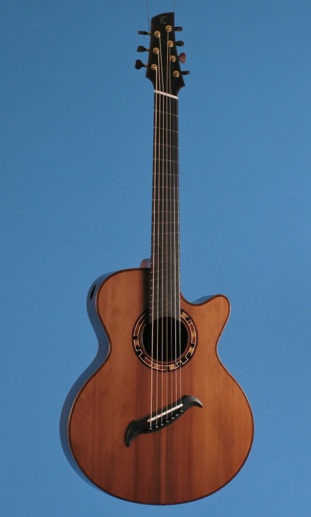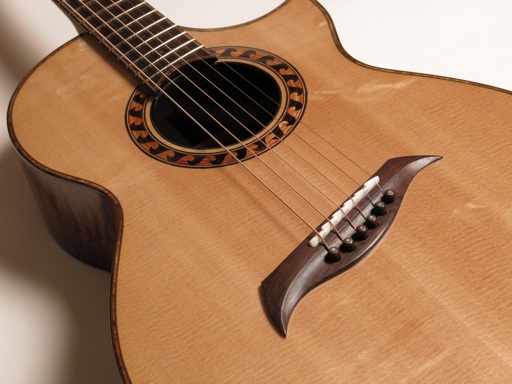Design Philosophy 7

Short Scale, Long Scale, Multi-scale
Thursday, August 8, 2013
Some fundamental facts about scale length are as follows:
Scale length is defined as the distance between the front edge of the nut and the center of the twelfth fret, (octave), times two. For example, if the exact distance between the nut and the twelfth fret is 12 1/2 inches, twice that measurement equals a scale length of 25 inches.
On a guitar, the actual length of the string from the nut to the bridge saddle is a fraction of an inch longer than the scale length number, to compensate for the slight rise in pitch that occurs when a string is pressed down to the fret. This extra length is called compensation, and is required to make the guitar play more in-tune. We’ll get into that in more detail shortly.

Shorter scale guitars are usually easier to play, owing to both the shorter distance between frets, requiring less reach to fret chords and notes, and because the reduced string tension makes it easier to press the strings down to the frets. This is a very important consideration if you are prone to carpal tunnel or tendinitis problems, or other physical conditions that would make playing a longer scale more difficult or even painful.
Longer-scale guitars generally have more “horsepower” than shorter scale guitars. Owing to the higher string tension, when a string is plucked, more (potential) string energy is transmitted to the guitar top. However, because of the higher tension of a longer scale, these guitars need to be more sturdily built in order to hold up structurally over the long term. Depending on how sensitively built (or not) the guitar is, this may somewhat negate the extra power of the string energy on a longer scale guitar.
Generally speaking, a shorter scale guitar needs to be more lightly and sensitively constructed in order to get the most tonal responsiveness out of it, owing to the lower string tension.
If you play mostly in standard tuning at concert pitch, you will do well with short, medium, or longer scales, depending on your comfort and preference.
If you play a lot in dropped tunings, where some of the strings are tuned down, you will benefit from having a longer scale, because the tuned-down strings will still have sufficient tension to keep them in tune, and prevent
rattling and buzzing.

the MultiScale Guitar
A multiscale guitar (also known as “fanned-fret) is a guitar which has the frets, nut, and saddle arrayed in such a way that each successively lower string has a progressively longer scale length. The photo at the header of this page shows one of my 2013 multiscale guitars. The scale spread on this Zephyr model ranges from 25” on the high E string to 25.75” on the low E string. This scale spread facilitates tuning down the lower strings to various D- or even C-based tunings. The increased scale length of each successively lower string keeps these strings at an acceptably playable tension when they are tuned down. The guitar plays wonderfully and stays in tune when it’s dropped down to DADGAD, or even CGCGCD. That’s pretty much the whole point of the multiscale guitar.

MultiScale, or fanned-fret guitars, have been becoming increasingly popular, especially among players of modern idioms, such as open-tuning “modern fingerstyle”, and also some adventurous and inventive Jazz players. Charlie Hunter is one of the leading users and advocates of fanned-fret guitars. Hunter’s mind-blowing technique and artistry on his Novax and Jeff Traugott fanned-fret guitars must be seen to be believed.
As far as I know, there are no factory-made multiscale acoustic guitars in production. If you want one, you need to have it custom made by a builder who knows how to do it. There are a number of luthiers who are making multiscale guitars now. I am glad to be one of them.
I am absolutely sold on the idea, and I now offer custom multiscale configurations on all my guitar models. The first one I built was a seven-string, semi-baritone Performance Cutaway, for Bob E., who lives in Calgary, Alberta. The photo above is Bob’s guitar.
The scale spread on this beast is 25.75” on the high E to 27.25” on the low B (seventh string). It was quite an adventure building Bob’s guitar, involving a great deal of careful planning and design work, taking into account the string tensions, internal bracing, etc.
I’m pleased to say it turned out extremely well. It sounds like a seven-string grand piano.

I love to make multiscale guitars. They are a lot of work, because so many things need to be altered from the standard guitar design to make them work. But it’s work I really enjoy doing, because the concept is so brilliant.
The headstock, nut, fingerboard, bridge, and saddle all need to be very carefully laid out for maximum accuracy; and the bracing of the top must also be shifted to accommodate the slant of the bridge.
The photo at left shows the bracing pattern I came up with for Bob’s prototype Edwinson multiscale guitar.
I have used similar layouts on other multiscale guitars, because this pattern works extremely well.
Considerations of the scale length of a guitar are very important to the form and function of the instrument. Many factors effect, and are effected by the scale length, including the ways that string tension relates to tone, how well the guitar plays in tune with various tunings, and also, the ease (or lack thereof) of playing the guitar. Scale length also factors into the overall engineering of the guitar, effecting things like bridge placement, bracing patterns and layouts, and neck construction. So, a good understanding of the variables involved in scale length is very important, when designing and optimizing a guitar for the kind of performance you require.


